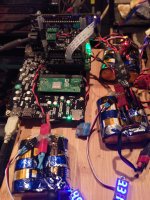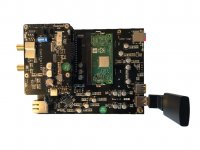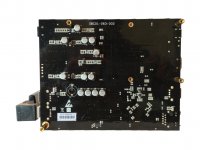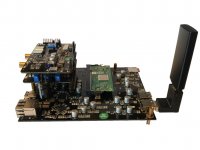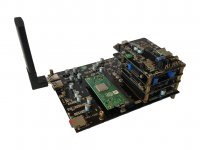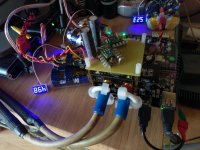New Revolution PCB was populated today and testing will start on Monday. I should be able to send samples before the end of next week for SQ assessments .
Will your finished DAC have a volume control, maybe a screen?
What type is the usb input? It doesn't look like a type B connector.
USB Type A
Will release more details soon ..
May I ask why Type A?
IMO, Type A tend to be loose fitting.
Why not Type C or B?
Thanks
Matt
Last edited:
Any comments on SQ in comparison to Sparky/USBridge?
Thanks
Matt
I don't have a Sparky so can't compare. Currently it's just hooked up to my Klipshh 2.1 desktop speaker system but at some point, after I ship moOde 6.3.0, I'll connect it to my Yamaha 2.1 Studio monitor system and dig in for serious listening and lightbulb loosening bass 🙂
.......but at some point, after I ship moOde 6.3.0, I'll connect it to my Yamaha 2.1 Studio monitor system and dig in for serious listening and lightbulb loosening bass 🙂
Please keep us informed about your impressions with the USB Sig in your big system.
May I suppose we can get it from Allo with moOde 6.3.0 in October?
Thanks
Matt
I think Allo is currently offering a moOde 6.2.1 image with enhanced driver etc. The 6.3.0 October release will be an in-place update and contains some nice enhancements to the Library, bug fixes and a few specials for the SIG 🙂
-Tim
-Tim
USBBridge running with piCorePlayer!
Many thanks to @Paul123 and the PcP team! I've got a USBBridge Signature setup running with their distro/SW combo.
They've added the ASIX Ethernet/USB driver(s) to their latest betas available here:
BETA: piCorePlayer6.0.0 - PI4 support
I'm using an Ian Canada GB FiFoPi / ES9028Q2M / IVStd stack as a test bed (Its a bit simpler setup than a Katana physically and in PcP, trying to limit variables for any troubleshooting needed... but it all worked right away once I used the new beta).
After less than 2 hours run-time, the setup is sounding VERY good with deeply dark and quiet backgrounds and a very dense, artifice-free, and articulate sonic presentation.
My initial impressions are that this setup will beat the same stack on one of my linear-regulated-modified RPi 2Bs using LDOVR.com's Mezzanine board, which themselves are a good step up from a stock RPi.
Power is my latest best setups... 2 DIY'd point-to-point Ian UCPi 2x350F Ultracap pair supplies float-charged to 3.3V by an Uptone Audio LPS-1.2 off-the-grid Ultracap supply on each. The USBBridge Signature is powered from another 2x350F Ultracap pair float-charged to 5V by either a Shanti or a modified K&K Audio Low Voltage supply. The output IV stage sports a pair of dual Sparkos discrete opamps and is powered by the +-13.2V outputs of Ian's LiFePO4 supply.
The 350F Ultracap pairs with the same float-charging scheme at 5V are working well on my main Katana setup too. I have yet to try powering the Opamp board with Ian's LiFePO4 supply, I'm expecting good results, perhaps next weekend.
I'm doing some component trials on my main Katana setup, which should be done this weekend. It'll go onto another USBBridge Signature then. I can't wait!
I believe Allo has another winner here! MANY THANKS Ioan and the rest of the Allo team for making one of my dreams come true!
Greg in Mississippi
P.S. Sorry for the busy picture... my power supply configurations are getting more complex with every iteration.
Many thanks to @Paul123 and the PcP team! I've got a USBBridge Signature setup running with their distro/SW combo.
They've added the ASIX Ethernet/USB driver(s) to their latest betas available here:
BETA: piCorePlayer6.0.0 - PI4 support
I'm using an Ian Canada GB FiFoPi / ES9028Q2M / IVStd stack as a test bed (Its a bit simpler setup than a Katana physically and in PcP, trying to limit variables for any troubleshooting needed... but it all worked right away once I used the new beta).
After less than 2 hours run-time, the setup is sounding VERY good with deeply dark and quiet backgrounds and a very dense, artifice-free, and articulate sonic presentation.
My initial impressions are that this setup will beat the same stack on one of my linear-regulated-modified RPi 2Bs using LDOVR.com's Mezzanine board, which themselves are a good step up from a stock RPi.
Power is my latest best setups... 2 DIY'd point-to-point Ian UCPi 2x350F Ultracap pair supplies float-charged to 3.3V by an Uptone Audio LPS-1.2 off-the-grid Ultracap supply on each. The USBBridge Signature is powered from another 2x350F Ultracap pair float-charged to 5V by either a Shanti or a modified K&K Audio Low Voltage supply. The output IV stage sports a pair of dual Sparkos discrete opamps and is powered by the +-13.2V outputs of Ian's LiFePO4 supply.
The 350F Ultracap pairs with the same float-charging scheme at 5V are working well on my main Katana setup too. I have yet to try powering the Opamp board with Ian's LiFePO4 supply, I'm expecting good results, perhaps next weekend.
I'm doing some component trials on my main Katana setup, which should be done this weekend. It'll go onto another USBBridge Signature then. I can't wait!
I believe Allo has another winner here! MANY THANKS Ioan and the rest of the Allo team for making one of my dreams come true!
Greg in Mississippi
P.S. Sorry for the busy picture... my power supply configurations are getting more complex with every iteration.
Attachments
Last edited:
My initial impressions are that this setup will beat the same stack on one of my linear-regulated-modified RPi 2Bs using LDOVR.com's Mezzanine board, which themselves are a good step up from a stock RPi.
Greg,
thank you, VERY impressive!
Now I am looking forward to a review where the SIG is powered by a Shanti only and feeding a DAC via USB.
Matt
USB Type A
Will release more details soon ..
Sure, no problem. When you are ready.
As for the usb connector I hope you will reconsider that typeA and go for a typeB input as most DACs do. And -why not- because some of us already have nice A->B usb cables that would want to reuse 🙂
Good luck with your projects, sir. It seems that you are not wasting your time.
Hi,
Here's some screen shots of the SIG + Katana + Comfast CF-912AC adapter.
The right angle USB connector is:
https://www.amazon.com/Adapter-Vertical-Coupler-Connector-Oxsubor/dp/B07C1Z552Z
Here's some screen shots of the SIG + Katana + Comfast CF-912AC adapter.
The right angle USB connector is:
https://www.amazon.com/Adapter-Vertical-Coupler-Connector-Oxsubor/dp/B07C1Z552Z
Attachments
This is a old question (USB vs Spidif)
The input that sounds best depends on input hardware implementation on your DAC.
USbridge Sig needs 5V input, you can use whatever PSU you want but for good performance we do recommend Shanti
I take your point about USB vs other inputs. To clarify, the impression I get is that the Digione Sig operates at a higher level than the original USBridge, as it should at a higher price. I think we all expect the USBridge Sig to operate at a higher level than the original USBridge, it will be very interesting to see just how much better it is. Other products on the market which use a RPi compute module in a bespoke board have been very well received. I am very optimistic.
Interesting review of Katana/Shanti on Allo's Katana Player & Shanti power supply | Darko.Audio
Shanti obviously adds tremendous upgrade over standard psu's , but comment on effect of isolator was not expected.
Its my feeling too, that the isolator, while making the background black, does reduce the 'dynamism' in the music.
USBBridge Sig + Katana & picorePlayer
I got my other setup running on a USBBridge Signature this afternoon. Power is basically the same as described in the setup above, but with all of the lower-voltage rails (USBBSig, Katana DAC board, and Microprocessor board) at 5V and the Katana Opamp board powered from a DIY AC-connected +-15V supply with the on-board DC-DC converters and LDOs bypassed.
SQ jump was immediately noticeable just as above. The difference from before was greater on this setup as the Katana was on a stock RPi 2B while the Ian GB FiFoPi/DAC pair above was already on a linear-regulator-modified RPi 2B using an LDOVR.com Mezzanine board. One thing that struck me with this setup (also quite apparent in the other) was the increased definition, impact, and dynamics in the bass regions... drums, bass, bass guitar, synth, etc all have an increased level of realism.
This has taken my Katana setup to a whole new level.
If you want to hear what your Katana can REALLY do, you need to do the following:
- AT A MINIMUM, power the Opamp board from a good +-15V separate power supply. Twisted Pear's Placid HD Bipolar and Salas UltraBiB are well received units though there are many others out there. I used a DIY'd supply with a hefty R-Core transformer, oversized low-noise diodes, 2 47,000uF/25V Jensen 4-Pole filter caps, and a pair of Sparkos +-15V regulators on a perf-board that mounts right on top of the Katana stack to keep the paths short after the regulation. Ian Canada's LiFePO4 board should do well too, though it is more expensive (with new name brand LiFePO4 cells) than any of the typical AC-connected supplies.
Once you do this, it gets even better if you bypass the +-14V LDOs on the Microprocessor board. Hopefully Allo will offer a good +-15V supply for the Katana in the near future.
- Power the Katana DAC and Microprocessor boards with separate 5V supplies. A Shanti works well for this. Use the 3.5A output on the DAC board.
- Use a USBBridge Signature instead of a stock RPi. Power it with a very good supply too... another Shanti works well here.
- Directly connect to power connection points on each board.
For details on how to do each of the above see this thread:
Getting the best out of Allo.com's new Katana DAC...
A Katana setup this way is a huge jump in SQ above the typical 2-3 5V supply setup on a stock RPi.
On use of an isolator, in my setups, to my ears, and with my preferences, I've always found isolators (Allo's or Ian Canada's) to be an improvement in lowering background noise and letting small details come through more clearly. I have heard a reduction in dynamics in some configurations. BUT I've always been able to remedy that with higher-current power supplies. PS Audio championed this since the middle 1980s when they sold an upgrade power supply for their preamps that consisted of the supply they used in their 70WPC amps. I tried this and found it a good and fairly cost-effective solution. For dynamics in audio, my experience is that overkill is always the right solution!
I've heard a similar effect when replacing DC-DC converter sections with linear regulation, such as above for the Katana Opamp board and when I modified a Sony HAP Z1-ES. I did some comparisons when I heard a reduction in dynamics and with extended listening, I could hear that the 'increased dynamics' was added noise that made it sound more exciting, but it got in the way of a lot of the lower-level details. To me the fix was always to go the low-noise way, but increase dynamics with a better power supply solution.
Greg in Mississippi
I got my other setup running on a USBBridge Signature this afternoon. Power is basically the same as described in the setup above, but with all of the lower-voltage rails (USBBSig, Katana DAC board, and Microprocessor board) at 5V and the Katana Opamp board powered from a DIY AC-connected +-15V supply with the on-board DC-DC converters and LDOs bypassed.
SQ jump was immediately noticeable just as above. The difference from before was greater on this setup as the Katana was on a stock RPi 2B while the Ian GB FiFoPi/DAC pair above was already on a linear-regulator-modified RPi 2B using an LDOVR.com Mezzanine board. One thing that struck me with this setup (also quite apparent in the other) was the increased definition, impact, and dynamics in the bass regions... drums, bass, bass guitar, synth, etc all have an increased level of realism.
This has taken my Katana setup to a whole new level.
If you want to hear what your Katana can REALLY do, you need to do the following:
- AT A MINIMUM, power the Opamp board from a good +-15V separate power supply. Twisted Pear's Placid HD Bipolar and Salas UltraBiB are well received units though there are many others out there. I used a DIY'd supply with a hefty R-Core transformer, oversized low-noise diodes, 2 47,000uF/25V Jensen 4-Pole filter caps, and a pair of Sparkos +-15V regulators on a perf-board that mounts right on top of the Katana stack to keep the paths short after the regulation. Ian Canada's LiFePO4 board should do well too, though it is more expensive (with new name brand LiFePO4 cells) than any of the typical AC-connected supplies.
Once you do this, it gets even better if you bypass the +-14V LDOs on the Microprocessor board. Hopefully Allo will offer a good +-15V supply for the Katana in the near future.
- Power the Katana DAC and Microprocessor boards with separate 5V supplies. A Shanti works well for this. Use the 3.5A output on the DAC board.
- Use a USBBridge Signature instead of a stock RPi. Power it with a very good supply too... another Shanti works well here.
- Directly connect to power connection points on each board.
For details on how to do each of the above see this thread:
Getting the best out of Allo.com's new Katana DAC...
A Katana setup this way is a huge jump in SQ above the typical 2-3 5V supply setup on a stock RPi.
On use of an isolator, in my setups, to my ears, and with my preferences, I've always found isolators (Allo's or Ian Canada's) to be an improvement in lowering background noise and letting small details come through more clearly. I have heard a reduction in dynamics in some configurations. BUT I've always been able to remedy that with higher-current power supplies. PS Audio championed this since the middle 1980s when they sold an upgrade power supply for their preamps that consisted of the supply they used in their 70WPC amps. I tried this and found it a good and fairly cost-effective solution. For dynamics in audio, my experience is that overkill is always the right solution!
I've heard a similar effect when replacing DC-DC converter sections with linear regulation, such as above for the Katana Opamp board and when I modified a Sony HAP Z1-ES. I did some comparisons when I heard a reduction in dynamics and with extended listening, I could hear that the 'increased dynamics' was added noise that made it sound more exciting, but it got in the way of a lot of the lower-level details. To me the fix was always to go the low-noise way, but increase dynamics with a better power supply solution.
Greg in Mississippi
Attachments
Last edited:
I got my other setup running on a USBBridge Signature this afternoon. Power is basically the same as described in the setup above, but with all of the lower-voltage rails (USBBSig, Katana DAC board, and Microprocessor board) at 5V and the Katana Opamp board powered from a DIY AC-connected +-15V supply with the on-board DC-DC converters and LDOs bypassed.
SQ jump was immediately noticeable just as above. The difference from before was greater on this setup as the Katana was on a stock RPi 2B while the Ian GB FiFoPi/DAC pair above was already on a linear-regulator-modified RPi 2B using an LDOVR.com Mezzanine board. One thing that struck me with this setup (also quite apparent in the other) was the increased definition, impact, and dynamics in the bass regions... drums, bass, bass guitar, synth, etc all have an increased level of realism.
This has taken my Katana setup to a whole new level.
If you want to hear what your Katana can REALLY do, you need to do the following:
- AT A MINIMUM, power the Opamp board from a good +-15V separate power supply. Twisted Pear's Placid HD Bipolar and Salas UltraBiB are well received units though there are many others out there. I used a DIY'd supply with a hefty R-Core transformer, oversized low-noise diodes, 2 47,000uF/25V Jensen 4-Pole filter caps, and a pair of Sparkos +-15V regulators on a perf-board that mounts right on top of the Katana stack to keep the paths short after the regulation. Ian Canada's LiFePO4 board should do well too, though it is more expensive (with new name brand LiFePO4 cells) than any of the typical AC-connected supplies.
Once you do this, it gets even better if you bypass the +-14V LDOs on the Microprocessor board. Hopefully Allo will offer a good +-15V supply for the Katana in the near future.
- Power the Katana DAC and Microprocessor boards with separate 5V supplies. A Shanti works well for this. Use the 3.5A output on the DAC board.
- Use a USBBridge Signature instead of a stock RPi. Power it with a very good supply too... another Shanti works well here.
- Directly connect to power connection points on each board.
For details on how to do each of the above see this thread:
Getting the best out of Allo.com's new Katana DAC...
A Katana setup this way is a huge jump in SQ above the typical 2-3 5V supply setup on a stock RPi.
On use of an isolator, in my setups, to my ears, and with my preferences, I've always found isolators (Allo's or Ian Canada's) to be an improvement in lowering background noise and letting small details come through more clearly. I have heard a reduction in dynamics in some configurations. BUT I've always been able to remedy that with higher-current power supplies. PS Audio championed this since the middle 1980s when they sold an upgrade power supply for their preamps that consisted of the supply they used in their 70WPC amps. I tried this and found it a good and fairly cost-effective solution. For dynamics in audio, my experience is that overkill is always the right solution!
I've heard a similar effect when replacing DC-DC converter sections with linear regulation, such as above for the Katana Opamp board and when I modified a Sony HAP Z1-ES. I did some comparisons when I heard a reduction in dynamics and with extended listening, I could hear that the 'increased dynamics' was added noise that made it sound more exciting, but it got in the way of a lot of the lower-level details. To me the fix was always to go the low-noise way, but increase dynamics with a better power supply solution.
Greg in Mississippi
Shanti should have had 3 power outputs: +-15V, 5v3A and 5v1A for best effect from Katana.
Shanti should have had 3 power outputs: +-15V, 5v3A and 5v1A for best effect from Katana.
Is there a socket on the Katana for adding the 15V psu?
Shanti should have had 3 power outputs: +-15V, 5v3A and 5v1A for best effect from Katana.
That means four power outputs, not three.
Then Shanti would have something like double dimensions and maybe double price.
Matt
Is there a socket on the Katana for adding the 15V psu?
There is a pin header and some jumpers for it, as explained in the Katana manual(s). However, some people prefer to use an alternate connection point which requires soldering and other modification.
Probably Shanti was built with Revolution DAC in mind, as Katana was not an average DIYer's cup of tea, and had to be simplified.
Hi,
Wanted to get opinions on which output to use on the digione signature.. im currently using rca cable to my dac but my dac has bnc inputs. Is bnc output is better than rca? I can get a bnc cable if its better but don’t want to bother if it’s insignificant.
Thanks
Wanted to get opinions on which output to use on the digione signature.. im currently using rca cable to my dac but my dac has bnc inputs. Is bnc output is better than rca? I can get a bnc cable if its better but don’t want to bother if it’s insignificant.
Thanks
- Home
- Vendor's Bazaar
- Shanti Dual LPS 5V/3A , 5V/1.5A
